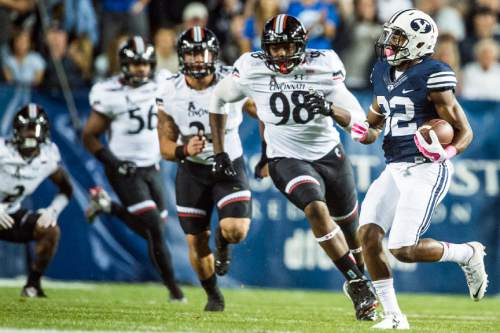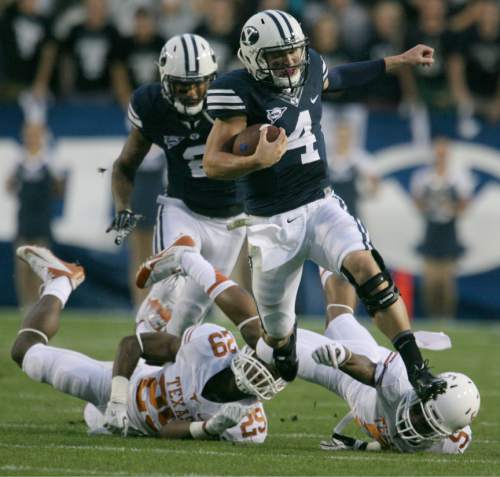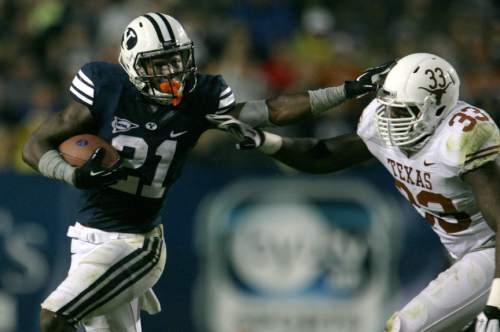This is an archived article that was published on sltrib.com in 2016, and information in the article may be outdated. It is provided only for personal research purposes and may not be reprinted.
You've heard the Big Dysfunctional might want to expand, might want to live up to its proper name and have, you know, a dozen schools. So, we're setting odds as to which school(s), if any, get(s) in. The process remains shrouded, at present, in a rolling bank of fog, probably because the conference itself doesn't know what it's doing with this kooky talk … this whole quaint, antiquated notion of having 12 members in the Big 12.
It's possible that it will live down to the aforementioned nickname, and find a way to mess over its own expansion, or … who knows, stand pat and not expand at all.
This is the same league that came within a few minutes of implosion in 2010, after Texas A&M, Missouri, Nebraska and Colorado bolted to better conferences, and Texas and Oklahoma were ready to do likewise.
What remains is a seemingly more stable, profitable group now, considering the bar was nearly subterranean a few years ago, a group that is rewarding its members with piles of cash stacked to a height of $20-plus million per year. The problem is this: Other conferences — such as the SEC — are scooping out bigger piles of cash, due, at least in part, to their own TV networks. The Big 12 wants some of that. And with the unsettled state of sports cable television money being what it is, that could take a while.
It also wants prestige and opportunity.
As is, the Big 12 is seen as the weakest — and smallest — of the Power 5 leagues, not necessarily as far as football goes, but through the lenses of solidarity and national perception. The once-splintered and -confused group is coming around to expansion and progress, although vision is still cluttered, confusion remains. It was longtime Notre Dame president Theodore Hesburgh who said: "The very essence of leadership is that you have to have vision. You can't blow an uncertain trumpet."
The Big 12 has been blowing it for too long.
The league had opportunity to expand earlier and multiple sources say it regrets not inviting Louisville when it had the chance. The fact that BYU, once a bit full of itself, wants badly into a formerly bumbling assemblage speaks to its own state of desperation. The financial/access/eminence gap between the P5 and the rest of college football is widening. Those familiar stinging words still ring true: Independence [for teams not named Notre Dame] isn't sustainable.
Whether the Big 12 can properly sustain itself, rather than fracture again, is more a conclusion than a puzzle, but not by as comfortable a margin as it would prefer.
The league recently hired Chicago-based Navigate Research to sort through analytics, presenting information at last week's conference spring meetings in Phoenix. It determined that prospects for the league in a given year of getting into the College Football Playoff, under its current structure, sit at 62 percent. If it added two teams and featured a championship game, that percentage, according to guys who study such things, would jump some 10 to 15 points.
Since getting a team into the playoff is a major goal, it seems reasonable to believe that it would be a no-brainer to expand. That's just one of the reasons Oklahoma president David Boren has been in favor of building on the conference's current number of 10. Boren also wants to create that Big 12 network.
Next thing, a fellow by the name of Max Weitzenhoffer, who happens to be the chairman of Oklahoma's board of regents, pops off and says he and other board members see no advantage to expansion, not by way of adding unwashed schools like BYU, Cincinnati, UConn, Memphis, Houston, Boise State, South Florida, UCF, and Colorado State.
"Those are the ones I keep hearing," Weitzenhoffer said. "They have no seating capacities in their stadiums. They really don't build them up. They really don't have any TV. I really don't know what we have to gain by that."
Pitted among the league's current schools, BYU's LaVell Edwards Stadium would rank third in overall capacity, at more than 63,000. Measuring BYU's fan base and the number of eyes it would draw to the league inside and outside of the Salt Lake City/Provo TV market, again compare favorably with the rest of the Big 12.
Later on Monday, Weitzenhoffer backed away from what he had said earlier, issuing a statement in which he reaffirmed "complete confidence" in Boren's leadership in matters concerning the Big 12: "He has and will continue to have my full support."
As one of the heads of the league's "expansion" committee, Boren is holding the line in favor of growth. All of which brings us to the most fascinating of questions: Which of the candidates might the league choose? A look at the candidates:
Cincinnati
The Bearcats appear to be a strong choice. And that has as much to do with West Virginia as the Queen City. The Mountaineers would love to have a regional partner and Cincinnati, which is a decent-sized market, has proved under Tommy Tuberville that it can field strong teams. Basketball success, though an afterthought here, doesn't hurt.
Odds • 2-1.
BYU
The Cougars have the best long-term football tradition, the largest fan following, the highest profile, the biggest stadium, a strong market, a major care-factor within its market, numerous eyes watching from outside its market, and perhaps the greatest chance for eventual success in the league among the possible additions. Ask the Longhorns about the Cougars having crushed them in recent seasons, and the Sooners about their loss to BYU at Jerry's Place.
So, what are the problems? You've heard them all before: Geography, no-Sunday play, BYUtv, misunderstanding — or understanding, depending on one's point of view — of the school's policies and its culture. Everything else being equal, BYU's inclusion would be a tomahawk dunk. Much of this stuff is solvable. Question remains: Is everything else equal?
Odds • 3-1.
Houston
The other Cougars, with their breakout football program, their setting in the heart of Big 12 country and large market would normally be seen as a strong possibility. But Texas already owns the Houston TV market and wouldn't be happy with another conference interloper on its turf. Is the league's national brand helped with Houston's addition? Ask Weitzenhoffer.
Odds • 5-1.
Memphis
The Tigers are in SEC country, and that's good for recruiting. The geography is relatively convenient. It's a nice-sized city. Football at the school has improved in recent seasons, although the effects of the loss of Justin Fuente to Virginia Tech remain to be seen.
Odds • 10-1.
Connecticut
UConn is attractive from a league network standpoint, located in the Northeast. Its basketball team isn't too shabby, but its football is a crater-sized blemish on the face of a candidate prancing down a runway through territory where beauty isn't just a bonus, it's a virtue.
Odds • 15-1.
Central, South Florida
The Florida schools — Central and South — are huge universities in bigger markets in fertile recruiting territory, but they would almost have to be a package deal, and that likely won't happen. Check back in a few years, when each of those programs is more fully developed, having found more success on the field and carrying more oomph than they currently offer.
Odds • 25-1.
Colorado State
The Rams get the Big 12 back into the Denver market, sort of, and while the Rams have had a decent run of football over the past couple of decades, they get invited only if BYU gets in. Even with plans for their new stadium, how much sizzle would the Rams bring? Not a lot.
Odds • 50-1.
Boise State
The Broncos bring great football and a small market that's far, far away. Love Boise, the town, but do Big 12 leaders share that opinion? It comes down to high quality of football versus distant geography and diminutive market size.
Odds • 50-1.
Others
Could the Big 12 poach a school from another P5 conference? Could it go after Northern Illinois? Tulane? UNLV? Two words: Extremely doubtful.
Odds • 100-1.
But, then, in the Big Dysfunctional, who really knows? Nobody.
GORDON MONSON hosts "The Big Show" with Spence Checketts weekdays from 3-7 p.m. on 97.5 FM and 1280 AM The Zone. Twitter: @GordonMonson. —
Big 12 expansion candidates
Boise State • Terrific football program; located in a small market that is far, far away.
BYU • Best football pedigree, large national following; would present geography, scheduling challenges.
Central Florida • Large market; recruiting hotbed; struggles for attention against Florida, FSU, Miami.
Cincinnati • Improved facilities; could provide partner for West Virginia; overshadowed by Ohio State.
Colorado State • New stadium in works; could bring Denver market; same geographical challenges as BYU.
Connecticut • Would provide foothold on East Coast; lots of basketball tradition, little football tradition.
Houston • Large market, stellar facilities, peaking football program — and right in middle of Texas' footprint.
Memphis • A medium market in heart of SEC country; football is better, but school lives and dies with hoops.
South Florida • See Central Florida. —
Big 12 members
Baylor
Iowa State
Kansas
Kansas State
Oklahoma
Oklahoma State
TCU
Texas
Texas Tech
West Virginia







